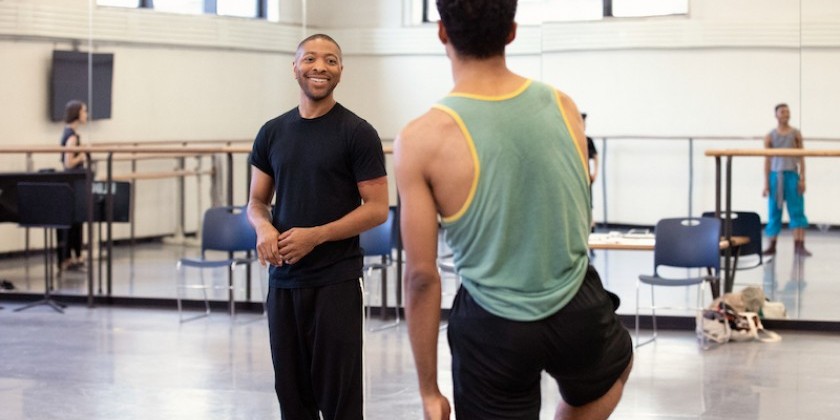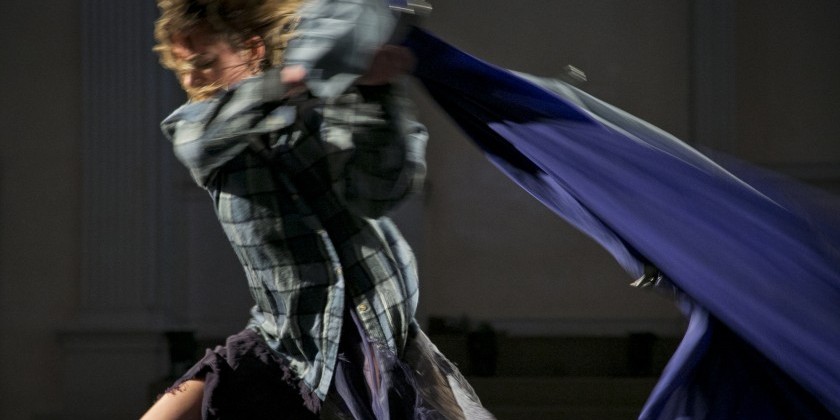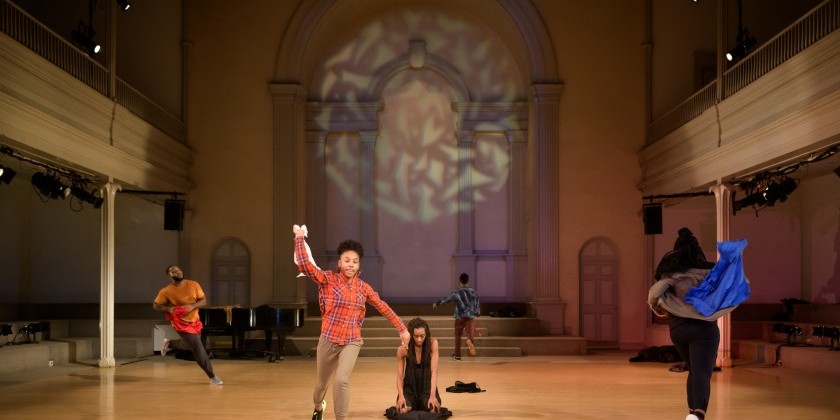Kyle Abraham on Choreographing for New York City Ballet and Revisiting "Dearest Home" at The Joyce

A.I.M’s Dearest Home: September 29-October 1, 2018 at The Joyce
Kyle Abraham’s Premiere for New York City Ballet runs September 27-28 and October 4 and 6
Pictured above: Kyle Abraham and NYCB Principal Dancer Taylor Stanley in the studio rehearsing Abraham’s new work for NYCB premiering on September 27.
Choreographer Kyle Abraham has had a transformative two years. He developed a solo for himself, the first in over a decade, as part of his company A.I.M’s spring Joyce season. In 2017, he tackled a work that was one of his most intimate, Dearest Home, which was colored by the death of his mother and the end of a long-term relationship. Later this fall, Abraham and A.I.M will perform in Europe, and upon their return to New York, he will receive the Princess Grace Statue Award.
But first, the busy choreographer will unveil two works that will run almost concurrently. Dearest Home will be reprised as part of the NY Quadrille Festival at The Joyce Theater. The second is his highly anticipated premiere for New York City Ballet — he’s the only African American dance maker to create a work on the company in over ten years. The news of his commission was a welcomed bright spot in midst of a turbulent period in the ballet’s history (In January, Ballet Master in Chief Peter Martins retired in midst of misconduct of allegations while this past month former SAB student Alexandra Waterbury filed a lawsuit against the company and former principal dancer Chase Finlay).
Abraham recently spoke to The Dance Enthusiast about his exciting season.
Trina Mannino for The Dance Enthusiast: How will the NY Quadrille run of Dearest Home differ from last year’s?
Kyle Abraham: I think there were some things I hadn’t realized while we were at The Kitchen. . . After that presentation, I started to dive in more and changed more of the choreography. The first duet has a different ending. There are some sections we cut completely. It’s a tighter work.
At the Kitchen, the audience had the option of watching the show with headphones on, which played a score by Jerome Begin, or watch in silence. And now the only option is silence. I think New York can handle it [laughs]. . .

In addition to a busy A.I.M season, you’re setting a premiere on New York City Ballet. How did the process with a ballet company differ from the way you work with your own ensemble?
KA: It’s different. I don’t know how often dancers in other companies are asked their opinions. But to me, it’s really important to talk and to get the dancers’ perspectives, because I’m not dancing it myself. I don’t know how things feel or how the flow feels to them. . . When I’m choreographing ahead of time for my company I have a sense of who will dance what and how to approach the music. I hire my dancers, in some cases, based on their different qualities of movement. But this was different. I had to find people who could already tap into a certain sensibility that I look for in my dancers. The key thing for me and my dancers is to have an openness and to try new things. That needs to be the case with anyone I work with. . .
When one sees your company, it’s apparent that your choreography is distinctly rhythmic and musical. But you don’t necessarily approach dance’s relationship to music in a traditional way. You’ve also mentioned you don’t use counts. Did think about music differently when choreographing for ballet?
KA: I was aware that there would be some people who might think that because I’m Black or because I work with contemporary or hip-hop music that I’m not musical, which is very misleading. . . I’ve played the cello [and piano] since I was a little kid, but I was also listening to hip-hop which is innately musical. . . and in a lot of cases poly-rhythmic.
The dancers who are the most open-minded are really the most musical in [the] sense that [their understanding] goes beyond 5678. Their musicality transcends the expression, and that is really key for me when I’m thinking of phrasing. I like it when you see an artist living in a work. It’s not about precision, but it’s about experience. It’s authentic.

How did you try to stay true to your signature vocabulary, which often encompasses social dances, modern and contemporary influences and hip-hop, with dancers who may not be versed in those forms?
KA: Some of them must make their way to the club from time to time [laughs]. My cast was open to trying things regardless if it was in their wheelhouse. A dancer like Ashley Bouder is a great example of that. She probably doesn't spend time in a hip-hop club or at a rave, but she’s so open, supportive and down to try anything. That inspires me. I need to have that energy around when I’m working. . .
In the press, you’ve talked about the pressure you felt to meet expectations after being awarded the MacArthur Fellowship. It appears this year was especially filled with growth, and you took risks in your work. What changed?
KA: Dearest Home was a big shift. Making that work and getting it out was very important to me: It was me saying ‘I can make something the way I want to make it, and I don’t have to try to meet people’s expectations’. . . After the first presentation, I felt hungry and happy about possibilities. . .
The work — a dance about love, longing, and lost — it’s not the happiest of subject matters. But, reflecting on the irony of the sad times it was created — my mother's passing, a major relationship coming to an end, the election — affected me in such a way. I spent time in a ‘woe-is-me’ phase. . . And then, when I turned 40 last year, I was on vacation — the first time I took a trip by myself. I was really reflective. I came home feeling blessed and grateful, and that’s the headspace I’ve been living in for the past year. . .
Is there anything else you’d like to add?
KA: City Ballet took a risk on me as a modern dance choreographer. I hope that ballet and the dance world in general can continue to find ways to be all the more inclusive. I’d love to see more women of color choreographing for ballet companies. It’s also important for us to think about trans artists and more opportunities for them. It’s an exciting time in the sense that there’s the potential for more individuals to be seen and heard and that people are open to listen to those voices.
The Dance Enthusiast Asks Questions and Creates Conversation.
For more of The Dance Enthusiast Asks, click here.
Share your #AudienceReview of the festival or others for a chance to win a prize.













